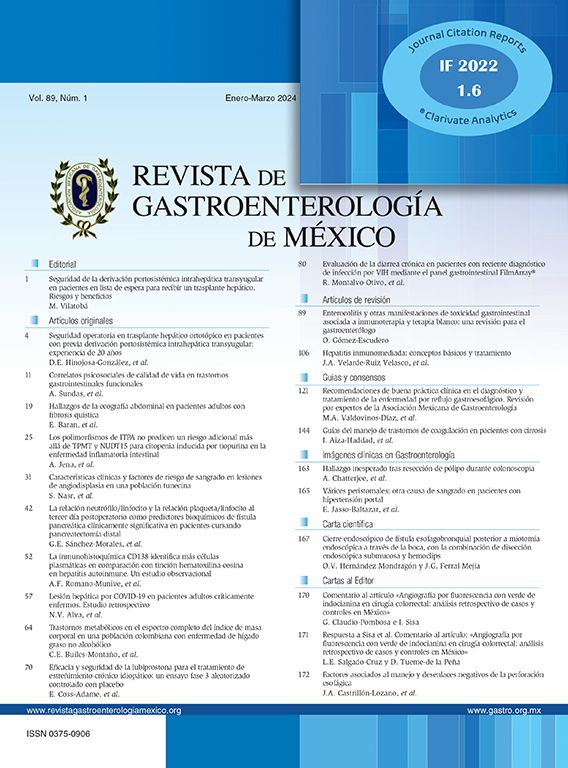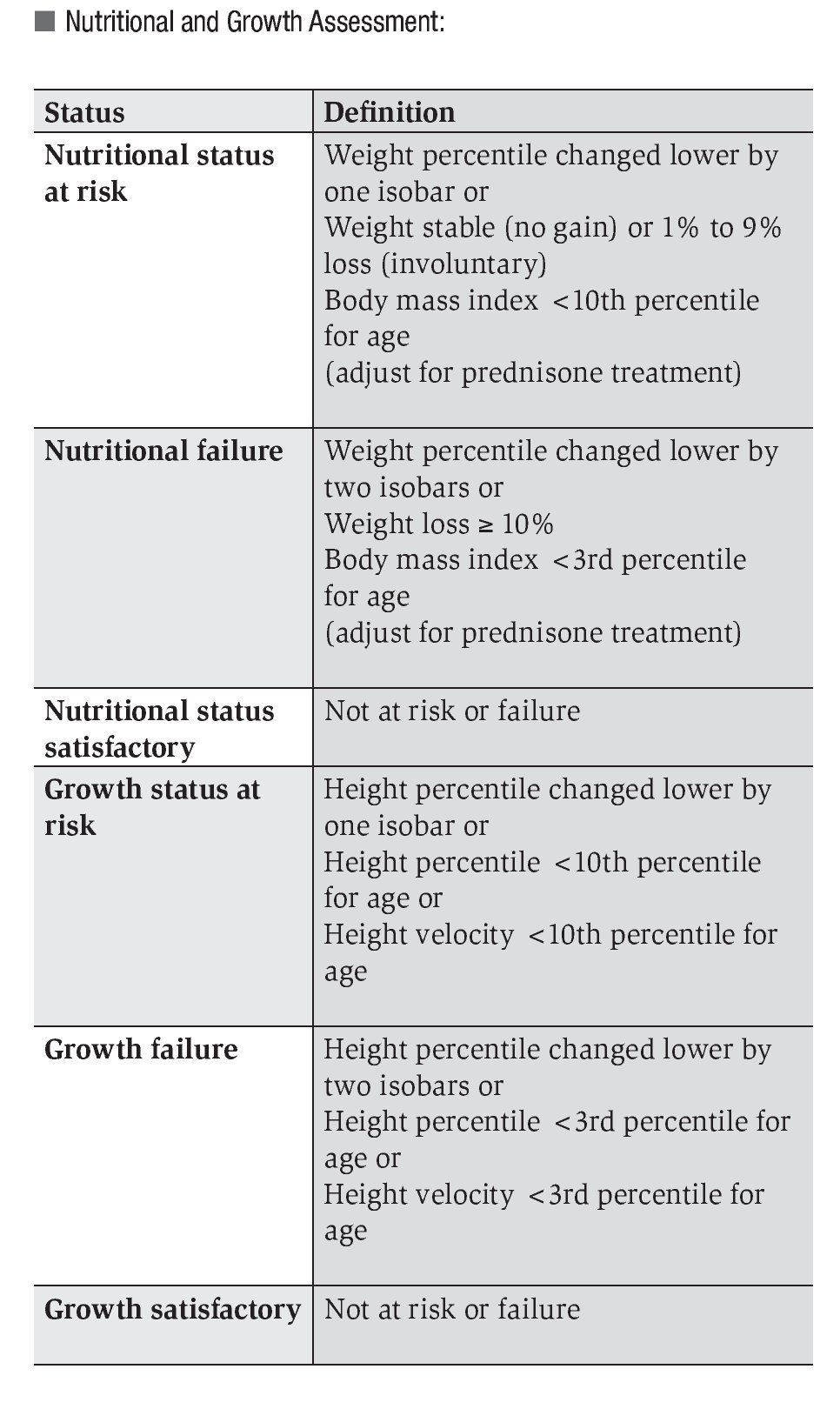Diagnostic and therapeutic interventions are appropriate and recommended for a very large percentage of children and adolescents with Crohn's disease and ulcerative colitis.1
¿ Complete Diagnostic and Initial Evaluation:
Complete blood cell count (CBC), erythrocyte sedimentation rate (ESR), and serum albumin
Esophagogastroduodenoscopy with biopsy and colonoscopy with biopsy
Imaging of the small intestine (upper gastrointestinal [GI] and small bowel series; or computed tomography [CT] scan with oral and intravenous [IV] contrast; or magnetic resonance imaging [MRI] with contrast enhancement; or capsule endoscopy)2
Other studies as indicated
Extent of Disease: documentation of disease location (esophagus, stomach, duodenum, jejunum, ileum, right colon, transverse colon, left colon, rectum, perineum)
Crohn's Disease Phenotype: based on the Montreal classification (non-stricturing, non-penetrating; penetrating; or stricturing)
Severity: Physician Global Assessment (quiescent, mild, moderate, severe)
Visit frequency: it is recommended that each patient be examined and evaluated at least once every 6 months (≤ 200 days)
¿ Treatment with 5-ASA:
When using the following medications, recommended doses are as follows:
1. Mesalamine 80 (60-100) mg/kg/day up to 4.8 g/day for active colitis
2. Mesalamine at least 30 (30-100) mg/kg/day up to 4.8 g/day for maintenance of quiescent or inactive colonic disease
3. Sulfasalazine 70 (50-80) mg/kg/day up to 4 g/day for active colitis
4. Sulfasalazine at least 25 (25-80) mg/kg/day up to 4 g/day for maintenance of quiescent or inactive colonic disease
¿ Treatment with Prednisone:
1. Prednisone is indicated for induction of remission. Long-term treatment with prednisone can induce significant adverse effects and has not been shown to be effective for maintenance of remission.
2. To induce remission the oral dose of prednisone is 1 mg/kg/d, rounding up to the nearest 5 mg, up to 40 to 60 mg per day, for 1 to 4 weeks.
3. Taper prednisone and discontinue it within 16 weeks after treatment has been initiated.
a. Prednisone resistance is defined as an inadequate improvement after 2 to 4 weeks of treatment.
b. Prednisone dependence is present when a patient, who initially improves in response to such treatment, develops a recurrence when the dose is being tapered or within 6 months after prednisone is discontinued.
¿ Treatment with Thiopurines:
1. Prior to initiation of a thiopurine, determine thiopurine methyltransferase (TPMT) geno-type or phenotype.
2. Choose a starting dose of azathioprine or 6-mercaptopurine (6MP) based on TPMT. Should TPMT activity be:
a. absent or very low, do not use a thiopurine.
b. intermediate, start azathioprine at 1.0 to 1.5 mg/kg/day or 6MP 0.5 to 0.75 mg/ kg/day.
c. normal to high, start azathioprine at 2.0 to 3.0 mg/kg/day or 6MP 1.0 to 1.5 mg/ kg/day.
3. For a maintenance dose of thiopurine use either at least the starting dose as defined above, or base the dose on blood concentrations of thiopurine metabolites or evidence of toxicity.
4. Monitor CBC and alanine aminotransferase (ALT) for evidence of toxicity.
5. For patients treated with a thiopurine, when disease is moderately or severely active it is recommended that the 6-TGN level be measured (if not done in the previous 90 days).
¿ Treatment with Methotrexate:
1. For induction of remission the recommended dose of methotrexate is 15 mg/m2 (up to 25 mg/m2) intramuscularly (IM), subcutaneously (SQ) or orally once a week.
2. For maintenance of remission the recommended dose of methotrexate is 10 to 15 mg/m2 (up to 15 to 25 mg/m2) IM, subcutaneous or oral once a week.
3. Folic acid supplementation is recommended in a dose of 400 µg or 1 mg per day.
4. Monitor CBC and ALT for evidence of toxi-city.
¿ Treatment with Infliximab:
1. It is recommended that a skin test (PPD) and/or a chest radiograph for tuberculosis be obtained before initiation of infliximab therapy.
2. For induction of remission it is recommended that infliximab 5 mg/kg IV (or rounding up to the nearest 100 mg) be used as an initial dose, with repeated doses of 5 mg/kg IV 2 and 6 weeks later (0, 2, 6 weeks).
3. For initial maintenance of remission it is recommended that infliximab 5 mg/kg IV (or rounding up to the nearest 100 mg) be given every 8 weeks.
4. For patients treated with infliximab, when disease is moderately or severely active it is recommended that the infliximab trough level be measured (if not done in the previous 180 days).
1 The guidance in this document does not indicate an exclusive course of treatment or serve as a standard of medical care. Variations, taking into account individual circumstances, may be appropriate.
2 In patients with left-sided ulcerative colitis (distal to the splenic flexure) in whom the terminal ileum is normal on colonoscopy, not performing small bowel imaging and/or esophagogastroduodenoscopy is also consistent with the ImproveCareNow Model of Care.
Bibliografía
Quality Improvement
1. Wolters FL, Russel MGVM, Stockbrugger RW. Systematic review: has disease outcome in Crohn's disease changed during the last four decades? Aliment Pharmacol Ther 2004;20:483-96.
2. Reddy SI, Friedman S, Telford JJ, et al. Are patients with inflammatory bowel disease receiving optimal care? Am J Gastroenterol 2005;100:1357-61.
3. McGlynn EA, Asch SM, Adams J, et al. The quality of health care delivered to adults in the United States. N Engl J Med 2003;348:2635-45.
4. Jha AK, Li Z, Orav EJ, et al. Care in U.S. hospitals—the Hospital Quality Alliance Program. N Engl J Med 2005;353:265-74.
5. Mangione-Smith R, DeCristofaro AH, Setodji CM, et al. The quality of ambulatory care delivered to children in the United States. N Engl J Med 2007;357:1515-23.
6. Haynes AB, Weiser TG, Berry WR, et al. A surgical safety checklist to reduce morbidity and mortality in a global population. New Engl J Med 2009;360:491-9.
Guidelines
1. Tremaine WJ, Sandborn WJ, Loftus EV, et al. A prospective cohort study of practice guidelines in inflammatory bowel disease. Am J Gastroenterol 2001;96:2401-6.
2. Kornbluth A, Sachar DB. Ulcerative colitis practice guidelines in adults. Amer J Gastroenterol 2004;99:1371-85.
3. Lichtenstein GR, Abreu MT, Cohen R, et al. American Gastroenterological Association Institute medical position statement on corticosteroids, immunomodulators, and infliximab in inflammatory bowel disease. Gastroenterology 2006;130:935-9.
4. IBD Guideline Team, Cincinnati Children's Hospital Medical Center: evidence-based care guideline for management of pediatric moderate/severe inflammatory bowel disease (IBD), http://www.cincinnatichildrens.org/svc/ alpha/h/health-policy/ev-based/ibd.htm, Guideline 29, pages 1-29, April 5, 2007.
5. Sandborn WJ, Feagan BG
6. Akobeng AK. Evidence base for interventions used to maintain remission in Crohn's disease. Aliment Pharmacol Ther 2008;27:11-18.
7. Panaccione, Rutgeerts P, Sandborn WJ, et al. Treatment algorithms to maximize remission and minimize corticosteroid dependence in patients with inflammatory bowel disease. Aliment Pharmacol Ther 2008;28:674-88.
Diagnosis and Classification
1. IBD Working Group of the European Society for Pediatric Gastroenterology, Hepatology and Nutrition (ESPGHAN). Inflammatory bowel disease in children and adolescents: recommendations for diagnosis—the Porto criteria. J Pediatr Gastroenterol Nutr 2005;41:1-7.
2. Satsangi J, Silverberg MS, Vermeire S, et al. The Montreal classification of in- inflammatory bowel disease: controversies, consensus, and implications. Gut 2006;55:749-53.
3. Walfish A, Sachar D. Phenotype classification in IBD: Is there an impact on therapy? Inflamm Bowel Dis 2007;13:1573-5.
4. Bousvaros A, Antonioli D, Colletti R, et al. Differentiating ulcerative colitis from Crohn's disease in children and young adults: a report of a working group of the North American Society of Pediatric Gastroenterology Hepatology and Nutrition, and the Crohn's and Colitis Foundation of America. J Pediatr Gastroenterol Nutr 2007;44:653-74.
5. Nikolaus S, Schreiber S. Diagnostics of inflammatory bowel disease. Gastroenterology 2007;133:1670-89.
Thiopurines
1. Winter J, Walker A, Shapiro D, et al. Cost-effectiveness of thiopurine methyltransferase genotype screening in patients about to commence azathioprine therapy for treatment of inflammatory bowel disease. Aliment Pharmacol Ther 2004;20:593-599.
2. Dubinsky MC, Reyes E, Ofman J, et al. A cost-effectiveness analysis of alternative disease management strategies in patients with Crohn's disease treated with azathioprine or 6-mercaptopurine. Am J Gastroenterol 2005;100:2239-47.
3. Pearson DC, May GR, Fick G, et al. Azathioprine for maintaining remission of Crohn's disease. Cochrane Database of Systematic Reviews (2):CD000067, 2008.
4. Colletti RB. Next steps on the TPMT 6-TGN pathway. J Pediatr Gastroenterol Nutr 2006;43:282-3.
5. Osterman MT, Kundu R, Lichtenstein GR, Lewis JD. Association of 6-thioguanine nucleotide levels and inflammatory bowel disease activity: a meta-analysis. Gastroenterol 2006;130:1047-53.
6. Banerjee S, Bishop W. Evolution of thiopurine use in pediatric inflammatory bowel disease in an academic center: role of thiopurine methyl transferase and 6-mercaptopurine metabolite measurements. J Pediatr Gastroenterol 2006;43:324-30.
Infliximab
1. Clark M, Colombel JF, Feagan BC, et al. American Gastroenterological Association consensus development conference on the use of biologics in the treatment of inflammatory bowel disease, June 21-23, 2006. Gastroenterology 2007;133:312-39.
2. Panaccione R, Fedorak RN, Aumais G, et al. Canadian Association of Gastroenterology clinical practice guidelines: the use of infliximab in Crohn's disease. Can J Gastroenterol 2004;18:503-8.
3. Maser EA, Villela R, Silverberg MS, Greenberg GR. Association of trough serum infliximab to clinical outcome after scheduled maintenance treatment for Crohn's disease. Clin Gastroenterol Hepatol 2006;4:1248-54.
4. Klotz U, teml A, Schwab M. Clinical pharmacokinetics and use of infliximab. Clin Pharmacokinet 2007;46:645-60.
Methotrexate
1. Turner D, Grossman AB, Rosh J et al. Methotrexate following unsuccessful thiopurine therapy in pediatric Crohn's disease. Amer J Gastroenterol 2007;102:2804-2812.





